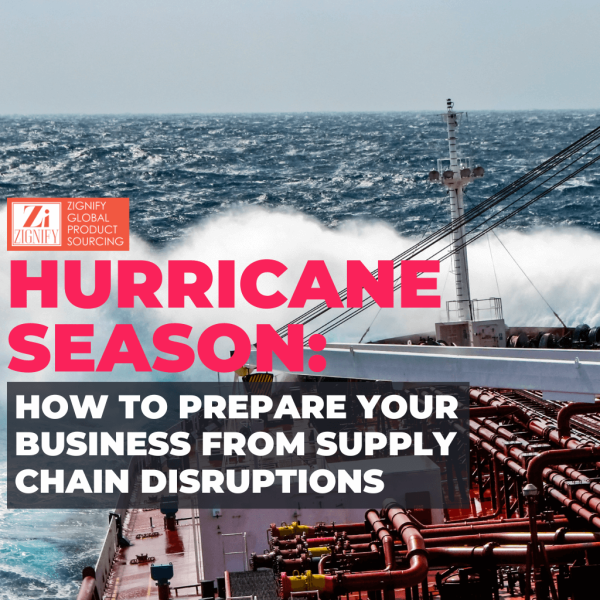
In recent years, the increasing frequency and severity of hurricanes, like Hurricane Helene and Hurricane Milton, have significantly impacted supply chains across the United States. These storms not only bring heavy rains and strong winds but also expose vulnerabilities in our global supply chains.
Coupled with the ongoing effects of the COVID-19 pandemic, and trade wars, businesses are facing unprecedented challenges. So, how can companies effectively navigate these disruptions?
Let’s dive into the impact of hurricanes on supply chains and explore proactive strategies to mitigate risks.
The Impact of Hurricanes on Supply Chains
- Infrastructure Damage:Hurricanes can severely damage critical infrastructure. For example, when Hurricane Helene hit, it temporarily shut down a major manufacturing facility in North Carolina, disrupting the national supply of IV fluids. Similarly, Hurricane Milton wreaked havoc on transportation networks, affecting both shipping routes and local logistics hubs. When roads, ports, and warehouses are compromised, the entire supply chain feels the effects.
- Shipping Delays:High winds and heavy rainfall often force airports and ports to halt operations. Tampa International Airport, for instance, ceased operations in preparation for Hurricane Milton, which led to logistical headaches for businesses relying on air transport. These delays can cause inventory shortages, especially for companies using just-in-time delivery systems where timing is critical.
- Increased Costs:
Hurricanes often lead to higher costs for businesses. Diverted shipping routes, alternative sourcing, and increased demand for supplies post-disaster drive prices up, squeezing profit margins. With essential resources in high demand, companies may face significant financial pressure. - Vulnerable Supply Chains:Companies heavily reliant on local suppliers are particularly vulnerable. If these suppliers struggle to recover after a storm, businesses can experience unexpected delays or outages. Since supply chains are interconnected, disruptions in one area can quickly cascade, affecting other regions and sectors.
Strategies to Mitigate Supply Chain Risks
While natural disasters like hurricanes are unavoidable, businesses can take steps to minimize their impact. Here are some proactive strategies to consider:
- Develop a Comprehensive Contingency PlanHaving a well-thought-out contingency plan is essential for responding to supply chain disruptions. This plan should include backup suppliers and alternative transportation methods, ensuring that operations can continue even when primary routes are unavailable. By preparing in advance, companies can reduce downtime and avoid scrambling during a crisis.
- Improve Supply Chain VisibilityLeveraging technology to gain real-time insights into your supply chain is crucial. With tools that offer up-to-date information on inventory levels and shipment statuses, businesses can quickly identify and respond to potential disruptions. Enhanced visibility allows companies to address issues before they escalate, helping to maintain smooth operations.
- Diversify Supplier RelationshipsRelying on a single supplier or region can be risky, especially during natural disasters. Diversifying your supplier network ensures that if one source is compromised, you have other options. This flexibility reduces the likelihood of major supply chain disruptions and helps businesses maintain resilience in the face of unexpected events.
- Maintaining an Inventory BufferKeeping a buffer of critical inventory on hand can help cushion the blow when supply chains are disrupted. However, it’s important to strike a balance—holding too much stock can tie up cash flow, while having too little leaves you vulnerable. The goal is to maintain enough inventory to handle disruptions without overstocking. Yulia Blinova recommends “Make a list of what to stock up on first. Focus on the essentials that will be most useful during a crisis”.
- Diversify Shipping RoutesRelying on a single shipping route or port can create bottlenecks during severe weather events. Companies should diversify their shipping routes by identifying alternative ports or transport hubs, including air freight options, to ensure goods continue moving even when primary routes are compromised. Establishing pre-arranged agreements with multiple carriers can also help minimize disruptions.
- Monitor External RisksRegularly assessing the geographic risks of suppliers and logistics providers allows businesses to stay informed about potential threats from extreme weather or other disruptions. With this information, companies can take preemptive measures to safeguard their operations and respond more effectively to challenges.
- Strengthen Communication ChannelsClear and consistent communication with logistics partners, suppliers, and customers is vital during extreme weather events. Businesses should ensure that all stakeholders are aware of potential delays and have contingency plans in place. Proactive updates help manage expectations and maintain customer satisfaction during disruptions.
- Leverage Predictive AnalyticsInvesting in predictive analytics can help businesses anticipate potential disruptions caused by hurricanes and other natural disasters. By analyzing historical data and current weather patterns, companies can make informed decisions about inventory management and shipping schedules ahead of time
Is Nearshoring a Solution?
One way to reduce dependence on distant suppliers is by embracing nearshoring. This involves moving production or sourcing closer to the home country. Nearshoring offers several advantages: shorter lead times, reduced risks associated with long transit routes, and overall stronger supply chain resilience.
While offshoring may have once been cost-effective, the risks of relying on suppliers far away have become increasingly apparent.
Diversification is key to supply chain resilience
Building a resilient supply chain means not putting all your eggs in one basket. Diversifying your supplier base, especially through nearshoring, can reduce the risks that come with relying on just one region or supplier. By sourcing from different geographic locations, companies can better handle disruptions, whether they stem from natural disasters, pandemics, or political challenges.
Leaning on a single supplier or region can make your business vulnerable to these risks. Exploring options like nearshoring and working with suppliers across various regions adds flexibility and adaptability to your supply chain, helping your business remain strong, even during unexpected challenges.
Final Thoughts
With disruptions becoming more frequent and severe, now is the time for businesses to enhance their supply chain resilience. Comprehensive contingency plans, diverse supplier networks, and technology that provides real-time visibility can help you stay ahead of future disruptions.
As climate change continues to reshape weather patterns and supply chain risks, proactive planning is key to keeping operations stable and thriving.
At Zignify Global Product Sourcing, we understand the importance of building a robust supply chain. Whether you’re looking to diversify your suppliers or explore nearshoring options, we’re here to help you navigate the complexities and strengthen your operations. Let’s connect and ensure you’re prepared for whatever comes your way!
